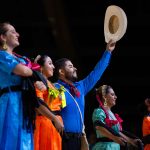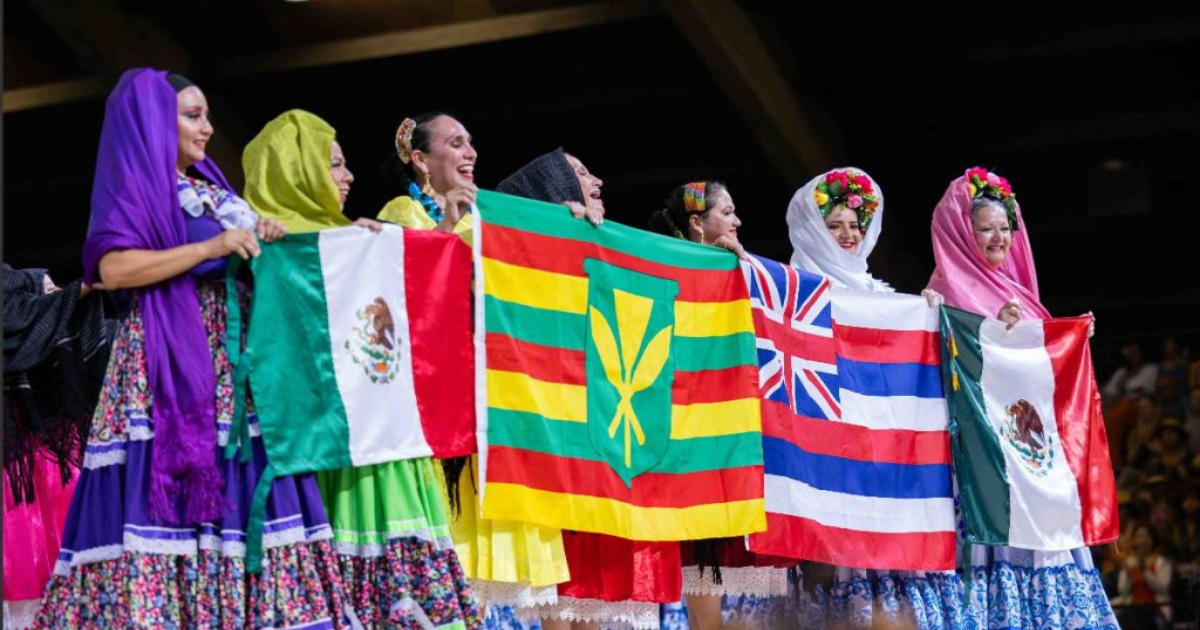Hōʻike Night at the 62nd Merrie Monarch Festival in Hilo. April 23, 2025. (Photo: SunRa Adziyaomamawu/For Big Island Now)
The Edith Kanakaʻole Multi-Purpose Stadium in Hilo was full of color and energy on Wednesday night, with hālau of Hawaiʻi and Japan, a dance studio from Mexico, kapa haka from Aotearoa, and a Polynesian dance studio from California all performing for the love of hula and their cultures.
It was Hōʻike Night, the exhibition that opened the 62nd annual Merrie Monarch Festival before the three-day competition begins tonight with Miss Aloha Hula.
Each year, the free exhibition performances also wow the audiences. And on Wednesday night, a surprise guest graced the Merrie Monarch stage to be honored and welcomed by thousands of people – Māori Queen Nga Wai Hono i te Pō, who has long been an active participant and tutor in kapa haka (Māori performing arts).
Nga Wai Hono i te Pō has become queen amidst tensions between Māori and the government that are at an all-time high. Her appointment is seen as a potent symbol of a new generation of Māori.
On Wednesday, Nga Wai Hono i te Pō was joined by supporters and their haka as a celebration of cultural pride, strength and unity.
ARTICLE CONTINUES BELOW AD
ARTICLE CONTINUES BELOW AD
Following the surprise appearance, Hālau o Kekuhi performed “Act V+1,” the finale of the hula drama “Holo Mai Pele.” The hula kahiko delves into the ending of the rivalry between Pele and her sister, Hiʻiaka.
Hōʻike Night at the 62nd Merrie Monarch Festival in Hilo. April 23, 2025. (Photo: SunRa Adziyaomamawu/For Big Island Now)
When Pele discovers that the man she loves, Lohiʻau, and Hiʻiaka have become lovers, she kills Lohiʻau and burns her sister’s ʻōhiʻa groves to the ground. This leads Hiʻiaka to stand up and face Pele in battle – an epic struggle that plays out to this day.
After each eruption, lava flows destroy the life in their paths, but before long, they become beds for ʻōhiʻa seedlings.
While hula kahiko is the traditional, powerful storytelling method, hula ʻauana represents the adaptation and resilience of cultural identity despite periods of suppression and marginalization.
Hula Hālau ʻO Leilani, under the direction of Mihoko Ogawa, from Chigasaki, Kanagawa, Japan, is living proof that the graceful and relaxed nature of hula ʻauana helps hula remain accessible and appreciated as an art form far outside of Hawaiʻi.
Hōʻike Night at the 62nd Merrie Monarch Festival in Hilo. April 23, 2025. (Photo: SunRa Adziyaomamawu/For Big Island Now)
ARTICLE CONTINUES BELOW AD
After exploring the history, art and expression of Hawaiʻi, Ka ʻOhana Kahikilaulani México displayed several traditional dances of Mexico, under the direction of nā kumu hula Rosalinda Parades, Araceli Garcia, Marcela Bermúdez, Brenda Morales, Dafne Peña, Donaleza Tovar and Brenda Ledezma.
Folklórico can be regionally specific, or the dances can bring regions together; some come from Aztec roots, while others are born from indigenous and European cultures.
Similar to Hawaiʻi, Mexico passes its myths, legends, tales and traditions through generations and through dance.
“I loved seeing the dances from Mexico, because you can see how meaningful it is for them to perform it for this many people,” Nani Milimilianālani said during Hōʻike. “They preserve their traditions and then tell the stories to us through a universal language (dance).”
The crowd continued to buzz with excitement through their presentation and during the kapa haka from Angitu, under the direction of Pere Wihongi, which is known for its social messages such as traditional gender roles in dance and the dangers of artificial intelligence.
ARTICLE CONTINUES BELOW AD
While the expression from Hawaiʻi and Mexico is often about history, haka is more present and used in celebration or protest. Most recently, a Māori member of the New Zealand Parliament, Hana-Rawhiti Maipi-Clarke, led a haka in protest of a bill that would reinterpret the country’s founding treaty with the Māori people.
“If someone’s got a problem with it, that’s their problem,” Maipi-Clarke said in an interview after the protest. “That’s not our problem because we’re doing everything to revive our culture knowing that it could be extinct.”

 Hōʻike Night at the 62nd Merrie Monarch Festival in Hilo. April 23, 2025. (Photo: SunRa Adziyaomamawu/For Big Island Now)
Hōʻike Night at the 62nd Merrie Monarch Festival in Hilo. April 23, 2025. (Photo: SunRa Adziyaomamawu/For Big Island Now)
 Hōʻike Night at the 62nd Merrie Monarch Festival in Hilo. April 23, 2025. (Photo: SunRa Adziyaomamawu/For Big Island Now)
Hōʻike Night at the 62nd Merrie Monarch Festival in Hilo. April 23, 2025. (Photo: SunRa Adziyaomamawu/For Big Island Now)
 Hōʻike Night at the 62nd Merrie Monarch Festival in Hilo. April 23, 2025. (Photo: SunRa Adziyaomamawu/For Big Island Now)
Hōʻike Night at the 62nd Merrie Monarch Festival in Hilo. April 23, 2025. (Photo: SunRa Adziyaomamawu/For Big Island Now)
 Hōʻike Night at the 62nd Merrie Monarch Festival in Hilo. April 23, 2025. (Photo: SunRa Adziyaomamawu/For Big Island Now)
Hōʻike Night at the 62nd Merrie Monarch Festival in Hilo. April 23, 2025. (Photo: SunRa Adziyaomamawu/For Big Island Now)
 Hōʻike Night at the 62nd Merrie Monarch Festival in Hilo. April 23, 2025. (Photo: SunRa Adziyaomamawu/For Big Island Now)
Hōʻike Night at the 62nd Merrie Monarch Festival in Hilo. April 23, 2025. (Photo: SunRa Adziyaomamawu/For Big Island Now)
 Hōʻike Night at the 62nd Merrie Monarch Festival in Hilo. April 23, 2025. (Photo: Kelsey Walling/Big Island Now)
Hōʻike Night at the 62nd Merrie Monarch Festival in Hilo. April 23, 2025. (Photo: Kelsey Walling/Big Island Now)
 Hōʻike Night at the 62nd Merrie Monarch Festival in Hilo. April 23, 2025. (Photo: SunRa Adziyaomamawu/For Big Island Now)
Hōʻike Night at the 62nd Merrie Monarch Festival in Hilo. April 23, 2025. (Photo: SunRa Adziyaomamawu/For Big Island Now)
 Hōʻike Night at the 62nd Merrie Monarch Festival in Hilo. April 23, 2025. (Photo: SunRa Adziyaomamawu/For Big Island Now)
Hōʻike Night at the 62nd Merrie Monarch Festival in Hilo. April 23, 2025. (Photo: SunRa Adziyaomamawu/For Big Island Now)







After an emotional haka, Nonosina, a world-renowned Polynesian dance company based in Anaheim, Calif., capped the festivities with its third Hōʻike performance during its 60th anniversary.
Ori dance was an important part of life in ancient Tahiti and was often performed without a special occasion. It is still used to pass down traditions to younger generations so that they can tell the stories of their ancestors.
Multiple generations of dancers from Nonosina were featured on stage for their performance to show that youth will continue to practice these deeply important cultural traditions.
Overall, the 2025 Hōʻike kept the energy high and was a reminder that artistic, physical expression such as hula, folklórico, haka and ori can be used to keep indigenous culture alive and to connect with others who are normally separated by time, language or an ocean.



